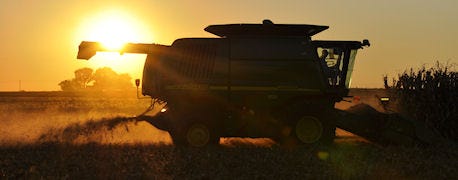
The farm bill as we know it has evolved over the past 81 years. Beginning as relief for farmers reeling from the Great Depression, the focus and methods have changed, but the intent is still the same: provide some stabilization to volatile farm incomes.
At times, farm programs have provided the majority of farm incomes, during other eras the programs have played only a small role.
Related: Learning continues on USDA's past and farm bill history

The American Farmer: "The farmer is the only man in our economy who buys everything at retail, sells everything at wholesale, and pays the freight both ways." John F. Kennedy
Johnson County, Indiana, FSA director Brian Catt offers a little farm bill history. He had done his homework, and some of mine. We set down in the conference room at the FSA office and talked farm bill history from 1933 to present. I walked away with a lot of information.
From the beginning, federal farm programs concentrated mostly on grains, leaving livestock, fruits and vegetables to self-align.
The 1933 act was the first time supply management was introduced. Farmers would be paid not to produce, an idea that had come up in congress before, as farmers struggled with poor incomes even prior to the Great Depression.
President Woodrow Wilson had vetoed several similar ag bills during the 1920s. He believed it wasn't the government's job to intervene. With the election of FDR and the implementation of the New Deal, modern farm policy started to evolve.
The government sought to establish grain reserves that could be used as needed. The Ever Normal Grainery Crop insurance appeared as a title for the first time in 1938. The 1949 farm law is considered the permanent law, even to this day, and all acts since then suspend it and replace it for a specific time period. Should those lapse, we revert back to the 1949 farm bill.
Related: More information about who signs FSA forms and gets payments
Nutrition programs have been a part of the farm bill from the very beginning but what we now call the food stamp program began in 1964. This made the farm bill palatable to a larger audience.
In the 1970s, times were good. My understanding was a lot of solitaire might have been played in the FSA offices during those good years.
Modern farm programs we recognize appeared in 1981. Participation had become very thin in the late 70s. Enrollment in farm programs ballooned a few years later in the early 80s as the ag economy collapsed.
Acronyms such as PIK, and LDP began to creep into farmers' vocabularies. Conservation was linked to farm program eligibility in 1985. The 1990 Farm Bill was the biggest ever, a stack of paper close to 4 feet tall or taller.
The 1996 Farm Bill aimed to decouple payments from production entirely, with the goal to eventually wean farmers from federal programs. When all said and done that farm bill had the opposite effect. Payments based on revenue have made their way back into programs since 2002.
Farmers are just now learning the specifics of the 2014 Farm Bill. The programs all have new names and mechanisms, but the original intent is still there – to provide a safety net for those responsible for our food supply when conditions beyond their control change.
About the Author(s)
You May Also Like




